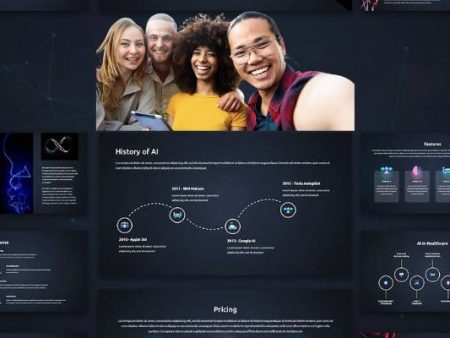Walk into a university library these days and you might be surprised at what’s on students’ screens.
Instead of PowerPoint slides being painstakingly assembled one rectangle at a time, you’ll often see AI-driven platforms like Tome, Canva’s Magic Design, or Beautiful.ai doing much of the heavy lifting.
For some professors, this feels like a double-edged sword. On one hand, students who struggle with design now have slick, professional-looking decks at their fingertips.
On the other hand, the nagging question remains: are these tools really helping students study, or are they just an elegant shortcut that encourages laziness?
The truth, as with most disruptive tech, lies somewhere in between.
The Context: Why Presentations Matter in Education
Presentations aren’t just about slides—they’re about communication, persuasion, and synthesis of knowledge. A good deck forces a student to:
- Understand their subject deeply.
- Organize thoughts in a logical flow.
- Translate complex material into digestible visuals.
- Deliver ideas confidently to peers and educators.
That’s why universities have long treated presentations as a core skill-building exercise. But AI complicates the equation. If a machine organizes the content and designs the visuals, what’s left for the student to actually learn?
This question isn’t unique to academia. We’ve seen it before in other fields. Look at how sales teams are adapting to AI presentation tools: they’re saving time on design so they can focus on strategy.
But in the classroom, the stakes are different—because the process of building slides is often part of the learning itself.
The Allure of AI: Why Students Are Hooked
Let’s be fair: students aren’t lazy by nature. They’re overloaded. Between part-time jobs, heavy course loads, internships, and social responsibilities, time is always scarce. AI promises relief.
Here’s why students flock to it:
- Speed: Instead of spending hours formatting slides, AI generates a first draft in minutes.
- Polish: AI tools guarantee sleek design that rivals corporate decks.
- Confidence: Students with weaker design or communication skills feel less exposed.
- Accessibility: Platforms with text-to-speech or auto-captioning help students with learning disabilities or international students still mastering English.
To them, AI isn’t “cheating”—it’s leveling the playing field.
The Criticism: Is It Just Laziness in Disguise?
Of course, critics aren’t quiet. Many educators argue that relying on AI for slides can short-circuit the learning process. After all, if a machine is doing the structuring, are students really grappling with the material?
Concerns include:
- Surface-Level Understanding: Students may present polished decks without deeply engaging with the topic.
- Skill Erosion: Designing presentations teaches visual literacy, attention to detail, and communication—a skillset that risks being lost.
- Ethical Gray Areas: Some tools blur the line between assistance and plagiarism, especially when AI generates entire scripts or citations.
These are valid fears. But we need to step back and ask: is the goal of academic presentations to teach slide design, or to teach communication of knowledge?
The Middle Path: AI as a Study Partner
What if we stopped looking at AI as a threat and started treating it as a study companion? Much like calculators didn’t kill math education but instead pushed it forward, AI could reshape the purpose of presentations.
Take ai-powered storytelling: turning dry research into narratives that classmates actually understand. For a biology student explaining gene editing or an economics student breaking down supply chains, AI can help visualize complexity in ways chalkboards never could.
Instead of replacing learning, AI might actually deepen it—if used consciously.
The Bigger Picture: AI in Different Contexts
This debate about “help vs. laziness” isn’t isolated to classrooms. Across industries, professionals are asking the same thing.
- In finance, the future of investor pitches is being shaped by AI tools that generate slick decks faster than ever. But investors still demand substance behind the slides.
- In sales, how sales teams are adapting AI presentations shows us that efficiency doesn’t equal laziness—it can mean focusing energy where it matters.
- In education, the same principle could apply: students spend less time on design mechanics and more time refining ideas and arguments.
The pattern is repeating everywhere—so maybe the classroom debate is just one version of a much larger cultural negotiation.
The Educator’s Dilemma: To Ban or To Integrate?
Some universities are tempted to ban AI tools outright, seeing them as shortcuts. But bans rarely work. Students find workarounds, and enforcement turns into a cat-and-mouse game.
Instead, the smarter path might be integration. That’s where ai for educators: reinventing the teaching approach comes in.
Educators could, for example:
- Require transparency: Students must declare which AI tools they used.
- Shift grading weight: Focus less on slide design, more on delivery and Q&A performance.
- Teach AI literacy: Help students learn how to use AI responsibly, rather than pretending it doesn’t exist.
- Incorporate critiques: Assign projects where students must evaluate the strengths and weaknesses of AI-generated decks.
By framing AI as part of the toolkit, not a crutch, educators can guide students toward responsible use.
Voices from Students: What They’re Saying
Interviews with Gen Z students reveal a spectrum of attitudes:
- Some see AI as indispensable, especially international students balancing language challenges.
- Others feel guilty, admitting that they lean on it when deadlines pile up.
- A minority reject it altogether, arguing it dulls their critical thinking.
This diversity of opinion shows us that the tool isn’t inherently “lazy”—it’s how individuals choose to use it.
Practical Case Studies
Case 1: The Engineering Student
An engineering student uses Tome to auto-generate diagrams explaining circuit design. Instead of struggling with Illustrator for hours, he spends that time rehearsing how to explain the process to peers. Outcome: better delivery, deeper understanding.
Case 2: The Philosophy Major
A philosophy student plugs essay notes into an AI tool to create slides for a class debate. The deck looks great, but when questions arise, she struggles—revealing that she hadn’t engaged deeply enough with the arguments. Outcome: shiny slides, shallow prep.
These cases illustrate both sides of the coin: AI can enhance learning, but it can also mask weak preparation.
Data and Trends
A 2023 survey by Intelligent.com found that 30% of college students regularly use AI tools for assignments.
Of those, more than half admitted to using them for presentation design. Interestingly, 67% of professors surveyed believed AI could help students if integrated responsibly, while only 22% favored outright bans.
This mirrors larger workforce trends: Gartner predicts that by 2026, 90% of corporate presentations will involve some AI-generated content. What starts in classrooms will echo in boardrooms.
My Take: It’s About Intent, Not Laziness
Here’s my personal opinion: AI doesn’t make students lazy. It magnifies intent.
- A motivated student will use AI to save time on formatting so they can rehearse, research, and refine their delivery.
- A disengaged student will use AI to dodge effort entirely.
The tool isn’t the problem—the intent behind it is. Just as spellcheck didn’t make writers lazy, AI won’t automatically ruin academic rigor. But educators need to adapt assignments to account for it.
Where We Go From Here
So, what’s the verdict? Is AI helping students or encouraging laziness? The unsatisfying but honest answer: both. It depends on context, intent, and guidance.
What’s undeniable is that AI is here to stay. Students will continue to lean on it, educators will continue to wrestle with it, and the debate will evolve.
But if we position AI not as a shortcut but as a shift in focus, we might unlock a healthier dynamic—one where presentations aren’t about flashy slides but about clear thinking and powerful communication.
Conclusion: Beyond Laziness
The bigger story isn’t about laziness at all—it’s about evolution. Just as typewriters gave way to word processors, and calculators changed math, AI is changing presentations.
The real test isn’t whether students use it—it’s whether they use it wisely. And that’s not just a classroom lesson. It’s a life lesson.
Because whether you’re a student defending a thesis, a consultant pitching a project, or a CEO in the future of investor boardroom, AI will be by your side. The question isn’t if—it’s how.


